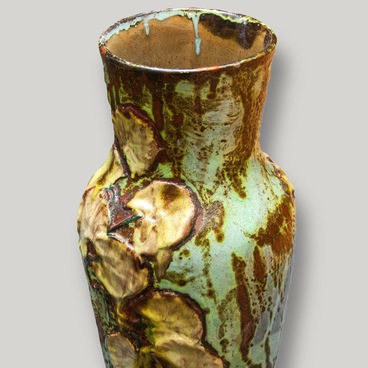The stone sacrificial slab was found accidentally in a plowed field near the city of Kurgan of the Tobolsk province. It was found by Reshetnikov, a student of the district school. There were no other objects of worship nearby. The slab was given to the Tobolsk Provincial Museum on May 27, 1891 by the priest Grivtsov. This is one of the first museum’s exhibits.
The found sacrificial slab is a solid stone of flat, slightly elongated shape with rounded edges. On the sides and planes of the stone, both upper and lower, there are traces of grinding, and the edges are smoothed. From the point of view of artistic execution, the sculpture is very schematic and resembles a ram’s head. The eyes are made in the form of bumps. The mouth is outlined by a simple facet that separates the upper and lower jaws.
Researchers believed that this sacrificial stone was used in the funeral rite, since such slabs were often left on mounds after performing ritual actions. It was assumed that they could represent a totem creature.
An important place in the structure of almost any ancient traditional ritual was occupied by the act of sacrificing something or someone. Accordingly, in most shrines, one of the main elements was the altar. It was a kind of sacred object, on which the sacrifice was performed. In the Indo-European culture, in which the stone had a special meaning, this material was very often used as an altar.
The time of existence of the archaeological monument found in Kurgan belongs to the Early Iron Age, i.e. from the 5th century BC to the 5th century AD. Most likely, this sacrificial slab can be attributed to the Scythian-Sarmatian era. The shape of the sacrificial slab is characteristic exclusively for the Trans-Urals and is not repeated anywhere in other regions. Images of rams were widespread in many cultures. Very often, they are found in Siberia starting from the Karasuk time.
The Karasuk culture is an archaeological culture of the Bronze Age of the late 2nd - early 1st Millennium BC, which was spread in southern Siberia and Kazakhstan. It is named after the excavations of reference monuments on the Karasuk River, a tributary of the Yenisei, near the village of Bateni in the Bogradskiy District of Khakassia.
The found sacrificial slab is a solid stone of flat, slightly elongated shape with rounded edges. On the sides and planes of the stone, both upper and lower, there are traces of grinding, and the edges are smoothed. From the point of view of artistic execution, the sculpture is very schematic and resembles a ram’s head. The eyes are made in the form of bumps. The mouth is outlined by a simple facet that separates the upper and lower jaws.
Researchers believed that this sacrificial stone was used in the funeral rite, since such slabs were often left on mounds after performing ritual actions. It was assumed that they could represent a totem creature.
An important place in the structure of almost any ancient traditional ritual was occupied by the act of sacrificing something or someone. Accordingly, in most shrines, one of the main elements was the altar. It was a kind of sacred object, on which the sacrifice was performed. In the Indo-European culture, in which the stone had a special meaning, this material was very often used as an altar.
The time of existence of the archaeological monument found in Kurgan belongs to the Early Iron Age, i.e. from the 5th century BC to the 5th century AD. Most likely, this sacrificial slab can be attributed to the Scythian-Sarmatian era. The shape of the sacrificial slab is characteristic exclusively for the Trans-Urals and is not repeated anywhere in other regions. Images of rams were widespread in many cultures. Very often, they are found in Siberia starting from the Karasuk time.
The Karasuk culture is an archaeological culture of the Bronze Age of the late 2nd - early 1st Millennium BC, which was spread in southern Siberia and Kazakhstan. It is named after the excavations of reference monuments on the Karasuk River, a tributary of the Yenisei, near the village of Bateni in the Bogradskiy District of Khakassia.

